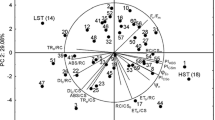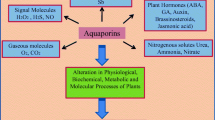Abstract
The present study analyzed the expression level of aquaporins of plasma membrane intrinsic protein (PIP) class in response to arsenite (AsIII) exposure of 100 μM from 0.5 h to 8 days in Brassica juncea. The expression levels of most of the PIPs were down-regulated during the course of AsIII exposure. This led to decrease in total water content of plants, which in turn hampered seedling growth. The level of reactive oxygen species (superoxide radicals and hydrogen peroxide), lipid peroxidation and root oxidizability increased significantly upon exposure to AsIII as compared to that of control leading to an increase in cell death. The study proposes that the down-regulation of PIPs happened presumably to regulate AsIII levels, which, however, occurred at the cost of reduced growth, disturbed water balance and induced oxidative stress.






Similar content being viewed by others
References
Neumann RB, St Vincent AP, Roberts LC, Badruzzaman ABM, Ali MA, Harvey CF (2011) Rice field geochemistry and hydrology: an explanation for why groundwater irrigated fields in Bangladesh are net sinks of arsenic from groundwater. Environ Sci Technol 45:2072–2078
Ali W, Isayenkov SV, Zhao F-J, Maathuis FJM (2009) Arsenite transport in plants. Cell Mol Life Sci 66:2329–2339
Rahman MA, Hasegawa H (2011) High levels of inorganic arsenic in rice in areas where arsenic-contaminated water is used for irrigation and cooking. Sci Total Environ 409:4645–4655
Zhao F-J, McGrath SP, Meharg AA (2010) Arsenic as a food chain contaminant: mechanisms of plant uptake and metabolism and mitigation strategies. Annu Rev Plant Biol 61:535–559
Gilbert-Diamond D, Cottingham KL, Gruber JF, Punshon T, Sayarath V, Gandolfi AJ, Baker ER, Jackson BP, Folt CL, Karagas MR (2011) Rice consumption contributes to arsenic exposure in US women. Proc Natl Acad Sci USA 108(51):20656–20660
Carbonell-Barrachina AA, Wu X, Ramirez-Gandolfo A, Norton GJ, Burlo F, Deacon C, Meharg AA (2012) Inorganic arsenic contents in rice-based infant foods from Spain, UK, China and USA. Environ Pollut 163:77–83
Ma JF, Yamaji N, Mitani N, Xiao XY, McGrath SP, Zhao FJ (2008) Transporters of arsenite in rice and their role in arsenic accumulation in rice grain. Proc Natl Acad Sci USA 105:9931–9935
Bienert GP, Thorsen M, Schussler MD, Nilsson HR, Wagner A, Tamas MJ, Jahn TP (2008) A subgroup of plant aquaporins facilitate the bidirectional diffusion of As(OH)3 and Sb(OH)3 across membranes. BMC Biol 6:26
Isayenkov SV, Maathuis FJM (2008) The Arabidopsis thaliana aquaglyceroporin AtNIP7;1 is a pathway for arsenite uptake. FEBS Lett 582:1625–1628
Kamiya T, Tanaka M, Mitani N, Ma JF, Maeshima M, Fujiwara T (2009) NIP1;1, an aquaporin homolog, determines the arsenite sensitivity of Arabidopsis thaliana. J Biol Chem 284:2114–2120
Li R-Y, Ago Y, Liu W-J, Mitani N, Feldmann J, McGrath SP, Ma JF, Zhao F-J (2009) The rice aquaporin Lsi1 mediates uptake of methylated arsenic species. Plant Physiol 150:2071–2080
Garey A-M, Norton GJ, Deacon C, Scheckel KG, Lombi E, Punshon T, Guerinot ML, Lanzirotti A, Newville M, Choi Y, Price AH, Meharg AA (2011) Phloem transport of arsenic species from flag leaf to grain during grain filling. New Phytol 192:87–98
Mathews S, Rathinasabapathi B, Ma LQ (2011) Uptake and translocation of arsenite by Pteris vittata L.: effects of glycerol, antimonite and silver. Environ Pollut 159:3490–3495
Mosa KA, Kumar K, Chhikara S, McDermott J, Liu Z, Musante C, White JC, Dhankher OP (2012) Members of rice plasma membrane intrinsic proteins subfamily are involved in arsenite permeability and tolerance in plants. Transgenic Res. Doi:10.1007/s11248-012-9600-8
Srivastava S, Suprasanna P, D’Souza SF (2012) Mechanisms of arsenic tolerance and detoxification in plants and their application in transgenic technology: a critical appraisal. Int J Phytoremed 14:506–517
Jha AB, Dubey RS (2005) Carbohydrate metabolism in growing rice seedlings under arsenic toxicity. J Plant Physiol 161:867–872
Singh N, Ma LQ, Vu JC, Raj A (2009) Effects of arsenic on nitrate metabolism in arsenic hyperaccumulating and non-hyperaccumulating ferns. Environ Pollut 157:2300–2305
Srivastava S, Suprasanna P, D’Souza SF (2011) Redox state and energetic equilibrium determine the magnitude of stress in Hydrilla verticillata upon exposure to arsenate. Protoplasma 248:805–815
Srivastava AK, Suprasanna P, Srivastava S, D’Souza SF (2010) Thiourea mediated regulation in the expression profile of aquaporins and its impact on water homeostasis under salinity stress in Brassica juncea roots. Plant Sci 178:517–522
Maurel C, Verdoucq L, Luu D-T, Santoni V (2008) Plant aquaporins: membrane channels with multiple integrated functions. Annu Rev Plant Biol 59:595–624
Clarkson DT, Carvajal M, Henzler T, Waterhouse RN, Smyth AJ, Cooke DT, Steudle E (2000) Root hydraulic conductance: diurnal aquaporin expression and the effects of nutrient status. J Exp Bot 51:61–70
Srivastava S, Srivastava AK, Suprasanna P, D’Souza SF (2009) Comparative biochemical and transcriptional profiling of two contrasting varieties of Brassica juncea L. in response to arsenic exposure reveals mechanisms of stress perception and tolerance. J Exp Bot 60:3419–3431
Chaitanya KSK, Naithani SC (1994) Role of superoxide, lipid peroxidation and superoxide dismutase in membrane perturbation during loss of viability in seeds of Shorea robusta Gaertn. f. New Phytol 26:623–627
Alexieva V, Sergiev I, Mapelli S, Karanov E (2001) The effect of drought and ultraviolet radiation on growth and stress markers in pea and wheat. Plant Cell Environ 24:1337–1344
Hodges DM, DeLong JM, Forney CF, Prange RK (1999) Improving the thiobarbituric acid-reactive-substances assay for estimating lipid peroxidation in plant tissues containing anthocyanin and other interfering compounds. Planta 207:604–611
Stoeva N, Berova M, Zlatev Z (2005) Effect of arsenic on some physiological parameters in bean plants. Biol Plant 49:293–296
Singh HP, Kaur S, Batish DR, Sharma VP, Sharma N, Kohli RK (2009) Nitric oxide alleviates arsenic toxicity by reducing oxidative damage in the roots of Oryza sativa (rice). Nitric Oxide 20:289–297
Schraudner M, Moeder W, Wiese C, Van Camp W, Inze D, Langebartels C, Sandermann H Jr (1998) Ozone-induced oxidative burst in the ozone biomonitor plant, tobacco Bel W3. Plant J 16:235–245
Wohlgemuth H, Mittelstrass K, Kschieschan S, Bender J, Weigel HJ, Overmyer K, Kangasjärvi J, Sandermann H, Langebartels C (2002) Activation of an oxidative burst is a general feature of sensitive plants exposed to the air pollutant ozone. Plant, Cell Environ 25:717–726
Han S, Kim D (2006) AtRTPrimer: database for Arabidopsis genome wide homogenous and specific RT-PCR primer-pairs. BMC Bioinformatics 7:179–188
Pfaffl MW, Horgan GW, Dempfle L (2002) Relative expression software tool (REST) for group-wise comparison and statistical analysis of relative expression results in real-time PCR. Nucleic Acids Res 30:e36
Siefritz F, Tyree MT, Lovisolo C, Schubert A, Kaldenhoff R (2002) PIP1 plasma membrane aquaporins in tobacco: from cellular effects to function in plants. Plant Cell 14:869–876
Yu L-J, Luo Y-F, Liao B, Xie L-J, Chen L, Xiao S, Li J-T, Hu S-N, Shu W-S (2012) Comparative transcriptome analysis of transporters, phytohormone and lipid metabolism pathways in response to arsenic stress in rice (Oryza sativa). New Phytol 195(1):97–112. doi:10.1111/j.1469-8137.2012.04154.x
Hartley-Whitaker J, Ainsworth G, Meharg AA (2001) Copper- and arsenate-induced oxidative stress in Holcus lanatus L. clones with differential sensitivity. Plant, Cell Environ 24:713–722
Luu DT, Maurel C (2005) Aquaporins in a challenging environment: molecular gears for adjusting plant water status. Plant, Cell Environ 28:85–96
Armstrong W (1967) The oxidizing activity of roots in waterlogged soils. Physiol Plant 20:920–926
Kedrova L, Saveljev J, Sheshegova T, Shirokhih I, Lisitsyn E (2003) Selection of winter rye (Secale cereale L.) for aluminum and acid resistance. Plant Breed Seed Sci 48:163–168
Alscher RG, Erturk N, Heath LS (2002) Role of superoxide dismutases (SODs) in controlling oxidative stress in plants. J Exp Bot 53:1331–1341
Mittler R, Vanderauwera S, Gollery M, Van Breusegem F (2004) Reactive oxygen gene network of plants. Trends Plant Sci 9:490–498
Author information
Authors and Affiliations
Corresponding author
Electronic supplementary material
Below is the link to the electronic supplementary material.
Rights and permissions
About this article
Cite this article
Srivastava, S., Srivastava, A.K., Suprasanna, P. et al. Quantitative real-time expression profiling of aquaporins-isoforms and growth response of Brassica juncea under arsenite stress. Mol Biol Rep 40, 2879–2886 (2013). https://doi.org/10.1007/s11033-012-2303-7
Received:
Accepted:
Published:
Issue Date:
DOI: https://doi.org/10.1007/s11033-012-2303-7




